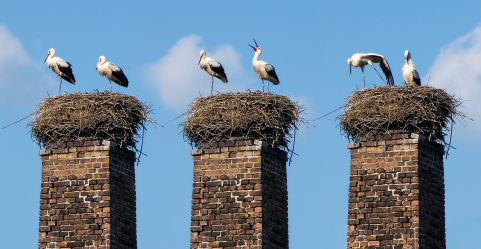
No, not a Trabant, the odd East German car affectionately dubbed the Trabi, but an enormous stork nest!
In Europe, three species of storks prefer to make nests on rooftops rather than in trees according to Wikipedia.
In the GeoGuide de la Croatie, you discover that there’s even a European stork capital in the Lonjsko Polje National Park, in the small village of Cigoc. How many years do you think a stork nest can remain attached to a roof? 1, 5, 10, 25, 50, perhaps 100 years?
If you guessed 50, you’re right. That’s half a century!
And how much does a nest weigh on average? 10, 50, 100, 500, 700 or 1000 kilograms?
700! That’s 1,543 pounds!
Imagine that on your roof! The structure of the house better be solid if you don’t want to have storks landing in your living room like Santa Claus.

Closer to us, golden eagles construct this type of nest.
According to Gaétan Duquette,* a specialist in records regarding birds, a golden eagle nest measures approximately 3.5 metres high by 2 metres wide. Its exact weight is unknown but must weigh hundreds of kilograms. Fortunately for us, this eagle doesn’t nest on houses.
Even if they’re not the same size, sparrow, starling, pigeon and other bird nests are not recommended on your house. Bird lovers would say that you shouldn’t disturb them in the spring when they nest. In fall and the beginning of winter however, they should be removed.
Be careful not to close a hole without removing every last bit of the nest. You could have an unpleasant surprise like a cacophony of birds in the attic, putrid smells of feces or even dead birds.
On a mild day, inspect the inside of your house. If you see twigs or traces of droppings, draw the birds outside with food, clean the space and plug all openings. Or call a specialist to visit your home.
Also remember to repair gutters, brick mortar, etc. Some birds only need a space the size of a $2 coin—a toonie, no less! So take a thorough look at your home!
*We’d like to thank Michel Robert and Gaétan Duquette for their contribution to this essay. Mr. Robert is coordinator for the Québec Breeding Bird Atlas and Gaétan Duquette is a specialist on bird records. He recommends the article QuébecOiseaux, vol. 21, number 4, page 39 in 2010.